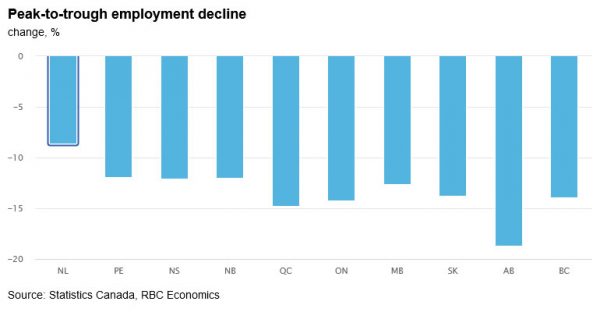The immensity of the COVID-19 shock to our economy is rapidly sinking in.
The immensity of the COVID-19 shock to our economy is rapidly sinking in. The mind-blowing 1 million job losses recorded nationwide in March far exceeded anything we’ve ever experienced. What’s more disturbing is this is likely to pale in comparison to the losses that will be reported for April. No region of the country is being spared from the shock. We have downgraded our provincial growth forecast (yet again!) across the board in light of recent developments and dynamics currently at play. We now project all provinces will slip into a severe recession this year. Still, we remain of the view the eventual easing of social distancing measures and unprecedented policy response will set the stage for a recovery (albeit partial) in the second half of 2020, returning provincial growth to the positive column in 2021.
The economic impact of COVID-19 will be widespread across the country irrespective of the number of cases in each province. This is because social distancing orders are in place everywhere and are directly disrupting big chunks of each provincial economy. Highly impacted industries like retail trade, transportation services (including airlines), education, arts and recreation, and food and accommodation services generally account for roughly one-third of jobs, and 20% to 25% of provincial GDP. Large portions of these industries going offline for a period of a couple of months would easily subtract between 3 and 4 percentage points from growth right off-the-top in most provinces.
Revised provincial forecast
Business closures, massive layoffs and drastically reduced working hours for those still employed generate additional knock-on effects for other sectors—leading to further job losses and deepening the economic contraction. The end result will be for 2020 to mark the steepest one-year decline in GDP for all provinces except Newfoundland and Labrador and British Columbia. The spike in unemployment in March and April will catapult the jobless rate into double-digits in every single province near term before gradually coming back down over the second half of this year. Alberta, Saskatchewan, and Newfoundland and Labrador won’t see single-digit unemployment again until 2021 at the earliest.
The outlook for oil-producing provincial economies is especially grim. The collapse in oil prices already delivered a brutal blow to businesses in the sector. Unfortunately, we expect oil prices to recover only very gradually over the coming year. Facing drastically reduced cash flows, producers are slashing investment and employment, and trimming output. We project employment to plummet by 440,000 in Alberta and 80,000 in Saskatchewan during this crisis. These represent nearly seven times and five times the losses suffered during the 2015-2016 recession, respectively. We see the unemployment rate surging to 20% in the current quarter in Alberta and 15% in Saskatchewan—both never-before-seen levels in these provinces.
As wicked as the COVID-19 pandemic shock will be to all provincial economies in the near term, we expect the eventual easing of social distancing orders to set the stage for a broad based recovery. The extraordinary policy measures put in place by all levels of government (by our count totaling almost $315 billion to date just between the federal government and the larger provinces) and the Bank of Canada over the past many weeks will facilitate this recovery. While much of the focus has been on federal initiatives, provincial governments have also implemented substantial measures to help individuals and businesses through this crisis. These include direct one-time payments to individuals in self-isolation or whose jobs have been affected by the pandemic, as well as bill and student loan payment deferrals. For businesses, some provincial governments offer emergency aid to help with liquidity ($2.5 billion in Quebec), loan guarantees, as well as deferrals of a range of taxes—from education property taxes to sales tax filings. Other provincial measures include direct support to hard hit industries like tourism and hospitality (BC for example is dedicating $1.5 billion to economic recovery efforts). All levels of governments and the central bank have indicated they’re prepared to do more if needed. We believe such unparalleled policy response will go a long way toward minimizing permanent damage to provincial economies, allowing recoveries to take hold across regions once the storm has passed.















